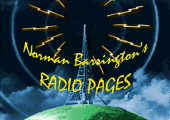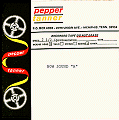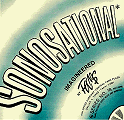    
| Notes on Jingles (aka Jingle
Notes) |
|
This page features Jingle-related history, anecdotes
and notes, from the jingle experts
|
Jingles from the USA
: No Longer a Big Export 
The world of jingles seems distant to me now. Maybe that is because
I am sitting on the deck of a vacation bungalow overlooking a warm lagoon.
Layers of wispy clouds float above the horizon on this tiny French Polynesian
island of Raiatea (pronounced rye-ee-ih-TAY-yah) near Tahiti.
But this locale caused me to think about how the U.S. used to export
jingles to countries all over the world. While the Brits sent us the
Beatles and Carnaby Street fashions, we sent them PAMS jingles. By the
late 60s, they were everywhere. Why did this happen and what has changed
so much since then?
While PAMS started as an advertising agency, it wisely hitched its star
to the rocket known as top-40, a thundering force in popular culture.
PAMS president Bill Meeks was friends with Gordon McLendon and Bill
Stewart, two pioneering program directors. The jingles Meeks created
were an important component of the format for more than a decade beginning
in 1960. The rest of the world wanted to sound like America.
But it is unlikely that the U.S. could ever regain its status as the
leading exporter of radio jingles for several reasons. Foremost, world
cultures have by now developed their own highly localized radio styles.
They no longer need our expertise. Another factor is accessibility of
technology. Anyone with a few thousand dollars in MIDI equipment and
a digital board can record music. And those styles have fragmented greatly.
Here in America black formats have splintered into rap, hip-hop, blues,
cool jazz, urban oldies and dozens of other categories. The same with
Hispanic music. Miami, Florida alone probably has ten Latino sub-genres.
In the U.K. new variations of dance, house and techo develop weekly.
It would be impossible for any U.S. producer to keep up with all those
trends, let alone satisfy the diverse tastes of listeners in the Bahamas,
Puerto Rico, Scotland, the Netherlands, Australia and all the other
locales where PAMS jingles once aired. Those countries used to take
their cultural cues from America, but no more.
Dallas simply no longer holds a monopoly on IDs around the world, or
even in the states. Visit www.reelworld.com to hear some highly competent
jingles produced in Seattle, for example.
What We Remember
Though the original incarnation of PAMS has been gone for 30 years,
many of us still remember those jingles with fondness. Those packages
were technically innovative, distinctive and they had an intensity that
perfectly suited the bombastic top-40 format.
PAMS jingles were not created by focus groups. Nor were they designed
to offend the smallest number of people. Each station using them was
encouraged to customize its cuts with variable logos and a wide variety
of lyrics. Today's jingle packages are often designed by group programmers
who dictate that all stations using them have almost identical versions.
In contemporary jingles just a few call letter melodies are used. While
IDs are still labor-intensive, they have become standardized to the
point where it is impossible to identify a producer by its product.
Jingles have become commodities. They no longer create trends; they
follow them.
In 1961 PAMS created Series 18 ("Sonosational") based on a
then-20-year-old electronic gimmick called the Sonovox. Having the instruments
"speak for themselves" was a brilliant application of a simple
technology. The novelty of Series 18 propelled it into virtually every
market and the series remained popular for the next 40 years. Bill Meeks
believed that if he could keep coming up with new twists, he would be
successful. And he was right, at least for the next decade.
Almost every PAMS package after Series 18 had an attention-grabber.
Series 20 ("Weatherettes") had tone-generated frequency sweeps,
up for good weather and down for bad. It also used sound effects such
as a fog horn, thunder and rain. Series 22 ("Sono-Magic")
brought back the Sonovox and threw in a calliope and prominent pedal
steel guitar. Series 23 ("Ani-Magic") used a very large orchestra
plus speeded up xylophones and other sounds added to the basic band
tracks. The hook in Series 25 ("The Happy Difference") was
a pair of young twin girls. Series 27 ("The Jet Set") had
several novel touches including the soaring soprano voice of Gleni Rutherford
added to the brass, and sound effects (directly from albums) of cars,
boats and a jet.
Many series used unorthodox recording techniques. Jingles were gargled
(Series 27), sung with speeded-up voices (Series 14, 16, 28) and patched
through various filters (Series 28, 35, 36, 40). The Moog synthesizer
(used on Series 32-49) and backwards tape effects (Series 27, 32, 39,
41) were also heard. Novelty jingles first appeared in Series 14 and
were used until the late 1960s.
While all the Dallas companies used skilled, flexible singers, PAMS
developed stars. Trella Hart (Series 32, 33), Peyton Park (Series 24,
25, 34, 36) and Gleni Rutherford (many series as part of the group,
Series 27 and 29 as a soloist) helped PAMS establish a unique brand.
Bass singer Jim Clancy began singing jingles in the late 1950s for PAMS
but after an absence, returned to take a full-time position in the late
1960s. His Texas drawl was put to good use as announcer, but it was
as the anchor of the vocal group that he is best known.
PAMS employed talented writers, some of whom were on staff in the 60s.
Euel Box, Bobby Farrar, Jodie Lyons and later Bob Piper were excellent
arrangers who brought a delightful sophistication and excitement to
the product.
Forces Coming Together
PAMS represented the "Perfect Storm," an accidental collision
of hip talent, electronic experimentation and the promotional knack
of Bill Meeks, who was president from 1951-1978. It all exploded as
top-40 hit its peak. Even though PAMS branched out into jingles for
other formats, it was top-40 that gave the company its status as a world
leader.
There were a number of reasons PAMS collapsed in the mid 70s including
some fatal management decisions by Meeks. But it is no coincidence that
AM top-40 also breathed its last about the time the original PAMS died.
TM, JAM and others continued to export the American sound for years
but the era of U.S. domination was over by 1976.
Most program directors of today were born after 1980. They were 10 years
old during the first Gulf War. They never used a turntable or a cart
machine. They always had e-mail. Now instead of a handful of AM stations
battling for the ears of the consumer, there are dozens of AM, FM, Internet,
satellite and iPod choices. Jingle collectors have repeatedly asked
me if the "PAMS sound" could ever return. My answer is that
it would be as likely as the return of the Charleston, the Model T or
the dial telephone. The right combination of conditions will likely
never be present again. This puts PAMS-style IDs into the category of
cultural artifacts which should be preserved and enjoyed.
It will never be 1964 again, and it is unlikely that the U.S. will be
a major exporter of jingles for the foreseeable future.
|
Ken R.
French Polynesia
January 1, 2007
|
|
|

